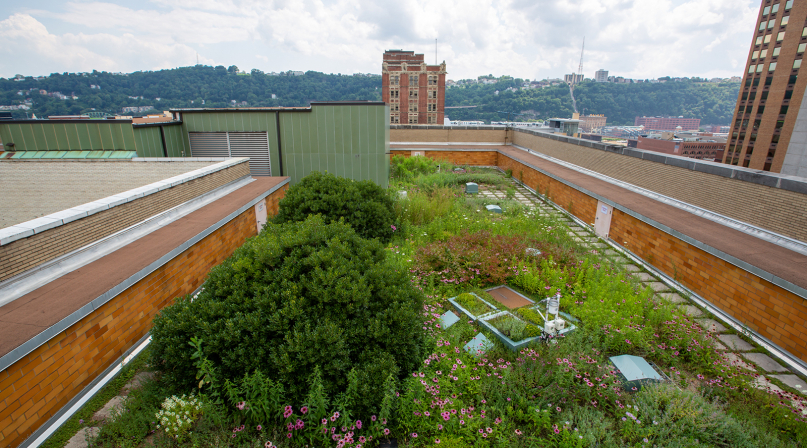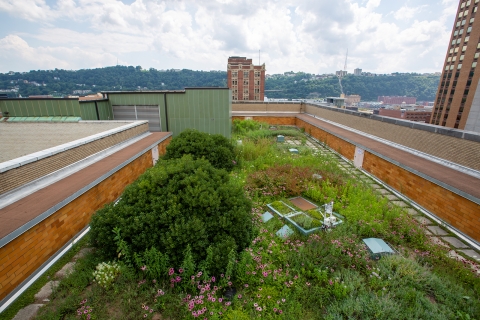Rooftop ‘growing green’ in Allegheny County
Author
Upcoming Events
Related News

On top of the county office building in Allegheny County, Pa., there’s more than just concrete and tar.
In 2010, the county installed an 8,400-square-foot green roof on the 1930s-constructed building in downtown Pittsburgh.
Darla Cravotta, Allegheny County’s director of community relations and special projects, helped to figure out a way to install the green roof.
Cravotta explained that the roof has two sides — the “control” side and the green roof. The ultimate goal of the project was to have the green roof act as a drainage system to hold water and keep it out of drains.
Nearly a decade later, the green roof has provided multiple benefits to the county.
On top of the county office building, there are different types of “green roofs” used to demonstrate how different green roof pieces can be used on existing buildings.
Allegheny County’s green roof features a mat filled with sedum, a type of plant that has a shallow soil depth of less than four inches. Other pieces on the green roof are described as “intensive” and “semi-intensive,” which have varying soil depths. The “semi-intensive” green roof is between 6 and 7 inches of soil while the “intensive” green roof can be up to 10 inches deep.
The different types of green roofs are all incorporated in the same space on top of the county office building.
“We wanted to build the roof to demonstrate what you could do on top of an existing building,” Cravotta said. “We did a variety of types of roofs on top so we could show people.”
The roof can capture an inch of rain in a 24-hour storm, according to Cravotta. Depending on the green roof type, the soil depth and the rain storm, the roof can capture anywhere from 20 to 100 percent of the rain.
“The green roof on the County Office Building has met and exceeded our expectations,” said Allegheny County Executive Rich Fitzgerald.
Cravotta said the green roof has an impact on the reduction in the urban heat island effect, which is caused when surfaces such as rooftops or concrete absorb heat during the day and re-radiate heat throughout the day and night. This makes the city hotter and results in higher cooling costs.
On the side of the top of the building with the green roof, the temperature is usually cooler by 20 to 50 degrees, Cravotta said. With the temperature reduction, the costs for running the HVAC are lower.
“The very first year we saw that our costs for our electrical savings in the first year were $80,000 because we put essentially an entire insulation on top of our roof,” she said.
Green roofs also help increase a roof’s lifespan by protecting the surface from UV rays, which cause wear and tear over time.
“If you’re a county and you have a budget, you’re going to be extending your roof life two to three times,” Cravotta said.
She added that the green roof helps with a major problem in Allegheny County — dealing with stormwater management — by collecting the rainfall.
“We wanted to demonstrate in an area that has a high concentration of concrete and existing older buildings, where you could install a green roof on top of a building,” she said.
“The county’s sustainability program really grew out of these efforts,” Fitzgerald added. “The roof project was our first foray into seeing what impact we could have at the county.”
Over the years, Cravotta said she has seen more biodiversity on the roof with an increase in bees, birds and has even seen a praying mantis.
“There’s things happening on that roof that normally wouldn’t happen on a flat, black tar roof,” she said.
Cravotta said there are various ways to incorporate green space on the top of buildings, and that can vary, depending on a roof’s loading capabilities. She said if the loading on a roof is minimal, a mat with sedum is an option that can help with stormwater management.
“The green roof is a way to help manage stormwater in cities that are experiencing and we all are — every city, every county — is experiencing this need to manage their water and a green roof is a way to do that and then also reap benefits especially on older buildings,” she said.
Allegheny County continues to monitor the green roof by tracking its rainfall data and posting the information on the county website, Cravotta said, noting: “The county saw this as a really important investment for us.”

Attachments
Related News

U.S. House of Representatives passes SPEED Act and other permitting reform bills
On December 18, the U.S. House of Representatives passed the SPEED Act (H.R. 4776). The SPEED Act would strengthen county involvement in decision-making and make needed commonsense reforms to the federal environmental review process.

House Natural Resources Committee advances the Endangered Species Act Amendments Act of 2025
On December 17, the House Natural Resources Committee advanced the Endangered Species Act (ESA) Amendments Act of 2025 (H.R. 1897). The version passed by the committee adopted several changes from the initial bill and would address key county concerns by improving the implementation of the ESA. The legislation now awaits a floor vote before the whole U.S. House of Representatives.

Senators introduce bipartisan UPGRADE Act to support small and rural public water systems
On December 15, Sens. Lisa Blunt Rochester (D-Del.) and Roger Wicker (R-Miss.) introduced the Unincorporated Partnerships for Grant Resources, Assistance, and Drinking Water Enhancements (UPGRADE) Act (S. 3465), a bipartisan bill that would strengthen federal support for small public water systems and helps unincorporated communities access clean and affordable water.
